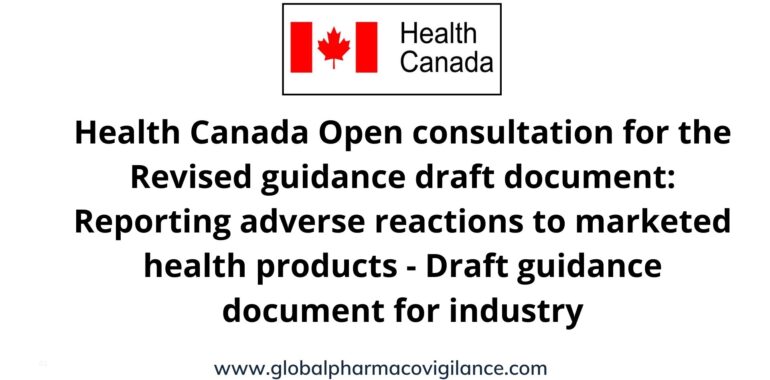Health Canada Open Consultation for Pharmacovigilance Professionals

Health Canada Open Consultation for Pharmacovigilance Professionals
Health Canada Open Consultation for Pharmacovigilance Professionals
Health Canada announced a 90-day consultation for the revised guidance draft document: Reporting adverse reactions to marketed health products – Draft guidance document for industry.
This guidance document covers the collection of individual adverse reactions (ARs) reports by Marketed Health Products Directorate (MHPD) for the following marketed health products:
- Pharmaceutical drugs (which includes prescription and non-prescription pharmaceutical drugs)
- Biologics as set out in schedule D to the food and drugs act (which include biotechnology products, din assigned manufactured blood products, and vaccines)
- Radiopharmaceutical drugs set out in schedule C to the food and drugs act
- Natural health products as defined in section 1 of the natural health products regulations
This guidance document does not cover the preparation and collection of summary reports, such as annual summary reports (ASR) and issue-related summary reports.
For assistance on how to comply with the Food and Drug Regulations and the Natural Health Products Regulations with respect to annual (C.01.018) and issue-related summary reports (C.01.019), MAHs should refer to the guidance document Preparing and Submitting Summary Reports for Marketed Drugs and Natural Health Products.
The objective of this consultation is to seek comments on the updated guidance document from all impacted stakeholders.
Since the last release of the guidance in 2018, Health Canada has identified a number of elements of the guidelines that need to be updated to further clarify adverse reaction reporting requirements.
Health Canada welcomes your comments on the proposed updates to ensure they are clear and relevant and support the understanding of regulatory reporting requirements for the industry.
Health Canada Open Consultation for Pharmacovigilance Professionals
Who is the focus of this consultation?
This consultation is looking for feedback from all interested Canadians, in particular:
- Market authorization holders
- Health product manufacturers
- Other interested stakeholders
How to participate
- Interested stakeholders should read and review the proposed draft guidance document.
- Comments on the draft guidance document can be submitted by e-mail to hc.canada.vigilance.sc@canada.ca with the subject heading “Industry Guidance Document – Consultation Comments”.
- Feedback received on or before April 25, 2021, will be considered when the draft guidance document is revised.
Do you want to part of the consultation? Click here for more info.
The contents of the Reporting adverse reactions to marketed health products – Draft guidance document for industry
Introduction
1.1 Scope
1.2 Adverse Reaction Reporting by Market Authorization Holders
1.3 Distinguishing Between Adverse Reactions and Adverse Events
1.4 Serious Adverse Reaction Reports
1.5 Determining if an Adverse Reaction is Unexpected
1.6 Regulations Pertaining to Adverse Reaction Reporting
2 General Procedures for Expedited Adverse Reaction Reporting
2.1 Domestic and Foreign Adverse Reaction Reports
2.1.1 Domestic Adverse Reaction Reports
2.1.2 Foreign Adverse Reaction Reports
2.1.2.1 Canada’s Access to Medicines Regime
2.2 Other Adverse Reaction Report Types
2.2.1 Overdose, Medication Error or Occupational Exposure
2.2.2 Pregnancy Exposure
2.2.3 Discontinued Products
2.2.4 Products with DINs Reported as Dormant
2.2.5 Unusual Failure in Efficacy (only applies to new drugs)
3 Good Case Management Practices
3.1 Minimum Criteria for an Adverse Reaction Report
3.2 Assessing Patient and Reporter Identifiability
3.3 The Role of Narratives
3.4 Follow-up Information
3.5 Evaluation and Coding of Adverse Reaction Reports
3.6 Contractual Agreements
3.7 Records to be Held for Auditing
3.8 Key Data Elements
4 Types of Adverse Reaction Reports
4.1 Unsolicited Reports
4.1.1 Consumer Reports
4.1.2 Scientific Literature Reports
4.1.3 Stimulated Reports
4.1.4 Reports via the Internet/social media
4.1.5 Other Unsolicited Reports
4.2 Solicited Reports
4.2.1 Reports from Patient Support and Disease Management Programs
4.2.2 Reports from Studies
4.2.2.1 Market Authorization Holder Sponsored Studies
4.2.2.2 Non-Market Authorization Holder Sponsored Studies
4.2.2.3 Post-Study Adverse Reactions
4.2.3 Blinded Study Reports (in Phase IV)
4.3 Reports from Regulatory Authority Sources
4.3.1 Submitting an electronic report involving new information associated to a CV 58 Online Database duplicate case
4.3.2 Submitting a manual report involving new information associated to a CV 60 Online Database duplicate case
4.3.3 Courtesy Adverse Reaction Notifications
Appendix 1 Glossary: Definitions and Terminology
Appendix 2 References
Appendix 3 Abbreviations
Appendix 4 Contact Information
Appendix 5 Other Adverse Reaction Reporting Programs Outside the Scope of this Document
Appendix 6 World Health Organization Causality Algorithm
Appendix 7 Summary of Expedited Post-Market AR Reporting Requirements to MHPD
Appendix 8 Determining when to report cases found in the Canada Vigilance Adverse Reaction 70 Online Database

ANVISA PBRER list 2021 (Brazil)
CIOMS role in Pharmacovigilance